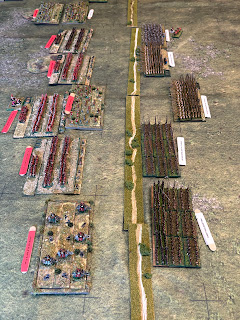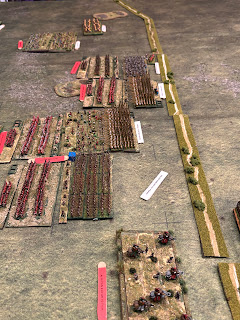In 168 BC, the Battle of Pydna marked a pivotal moment in the Roman Republic's conflict with the formidable Kingdom of Macedon. In a previous blog, I explained the preparation, research, and several potential 'What Ifs. The one played in this simulation was where the terrain favoured the Phalanx, with less broken ground.
The Historical Battle
Had the following phases.
- Skirmish triggers deployment
- Initial clash - Phalanx gains advantage on flat ground
- Terrain disruption - As Phalanx pushes the Romans back, their formation gets disrupted.
- Roman exploitation - Manipular flexibility exploits gaps
- Macedonian collapse - Battle line collapses
- Rout
My Simulation
The Reluctant Advance
As the first light of dawn broke over the battlefield, two foraging parties clashed near the dry river bed. A brief skirmish ensued, during which the Roman light infantry was victorious, causing their Macedonian opponents to retreat in rout. This initial success would cause Aemilius Paulus a problem because the light infantry started to loot the bodies of their victims rather than retire to safety.Whilst the skirmishes were fought, the two armies took cautious steps forward to support their companions. King Perseus of Macedon felt a heavy burden of uncertainty weigh upon him, causing him to hesitate. This reluctance fragmented his formation, with the Phalanx's left and centre surging ahead, leaving him and the right wing lagging behind. Seizing the moment, Aemilius Paulus moved his Legion forward, supported by the elephants on their right.
The Phanlanx and the Legions Advance
A Battle of Attrition
As the Phalanx rolled forward like a tide, Perseus finally regained control over his battleline, guiding them across the dry streambed in a solid line. Meanwhile, Aemilius Paulus faced significant setbacks. His advance was stifled by the remnants of the victorious light infantry, who seemed utterly absorbed in looting the fallen Macedonian soldiers rather than providing vital support to their comrades.
On the Roman right flank, colossal war elephants struggled against the uneven ground, their lumbering frames hindering the cohesion of Paullus' force and splintering any chance of an effective attack. In the ensuing chaos, Roman cavalry engaged in fierce skirmishes, pushing the Thracians back but inadvertently distancing themselves from the main body of their army. The Roman line had started to fragment.The Phalanx pushes the Legion backwards. In the Middle of the line, the Roman Light Infantry
Remained trapped between the two masses.
Impetuous Cavalry?
In a mirror image of the Roman troubles, the Macedonian right flank saw Perseus' heavy cavalry chase off the Numidians, only to find themselves unable to rein in the wild pursuit, creating a precarious imbalance as zeal surged within their ranks.
Collision of Forces
The moment of reckoning arrived with a visceral clash; the two armies collided. The disciplined Macedonian Phalanx drove forward, initially gaining the upper hand and forcing the Roman legions uphill onto the rocky, unforgiving terrain. Yet the Roman velites proved to be an insufferable thorn in the side of their advance, thwarting their every move and creating chaotic gaps in the Macedonian centre.
Perseus found himself grappling with a dual challenge as his victorious cavalry struggled to regain control, unable to shift their focus back to launch an attack on the Roman left flank and rear, while the battle line fragmented, leaving the Macedonians more vulnerable than the Romans to exploitation.
Perseus found himself grappling with a dual challenge as his victorious cavalry struggled to regain control, unable to shift their focus back to launch an attack on the Roman left flank and rear, while the battle line fragmented, leaving the Macedonians more vulnerable than the Romans to exploitation.
The Turning Point
As the sun began to dip low in the sky, the tide of Battle seemed to sway precariously. The Galician mercenaries, once a bulwark for the Macedonian side, turned tail under pressure from the relentless Ligurians, further unravelling the Macedonian lines. The momentum shifted as the Roman forces finally orchestrated their regrouping, turning the tide against the Macedonian onslaught, albeit with their cavalry still isolated from the main action.
The heart of the battlefield, the decisive ground where fate would be determined, pulsated with tension as both sides prepared for what could prove to be the calamitous conclusion to this struggle.
The heart of the battlefield, the decisive ground where fate would be determined, pulsated with tension as both sides prepared for what could prove to be the calamitous conclusion to this struggle.
The Final Push
In a dramatic turn of events that seemed ripped from the pages of Hollywood, the Macedonian cavalry commander brought his men's battle lust under control and managed to re-enter the fray, charging fiercely into the flank of Paullus' Legion. Recognising the urgency of the moment, Paullus committed his triarii to the Battle, and while the Roman Legion held firm, they became disordered under the double Macedonian assault.Now victory appeared to hang tantalisingly within Perseus' grasp, he called out "Homunculus Est," urging his troops to claim victory. Success, the might of the Republic had broken.
A Close Call
History would remember Perseus' victory as a close escape. Had the Romans made the call at the end of the previous turn, they would have seized a stunning triumph. Overall, the Battle was a hard-fought contest, where both sides emerged battered but unbroken. Unlike the historical engagement, the 3rd Macedonian War would not end in a Pynda. Rome would seek revenge, while Perseus might have released the purse strings to purchase more mercenaries.
The Final Moves. The fighting has broken into clumps, but at the top of the picture,
the Macedonian Cavalry has turned to attack the Roman Flank
Some Thoughts
Despite the outcome, the Battle followed the historical sequence of events closely. Besides some bad dice throws, the omens favoured Macedon.- The Roman light infantry's early success was a curse to Paulus. A series of poor dice rolls meant they hindered the Legion's advance. In the end, Paulus sacrificed them so he could get his legions into action, although the delay was probably costly. The opening light infantry should occur on one of the flanks rather than the centre of the battlefield.
- The Macedonian cavalry played a more prominent role, fulfilling its intended purpose in Successor armies. In the historical Battle, they are invisible, and the sources do not answer why they did not play a prominent part.
- Last, the reduction in broken ground allowed Perseus to keep the Phalanx together, even when pushbacks fragmented the line. The fewer gaps were never sufficient to permit the Romans to exploit their flexibility.







No comments:
Post a Comment